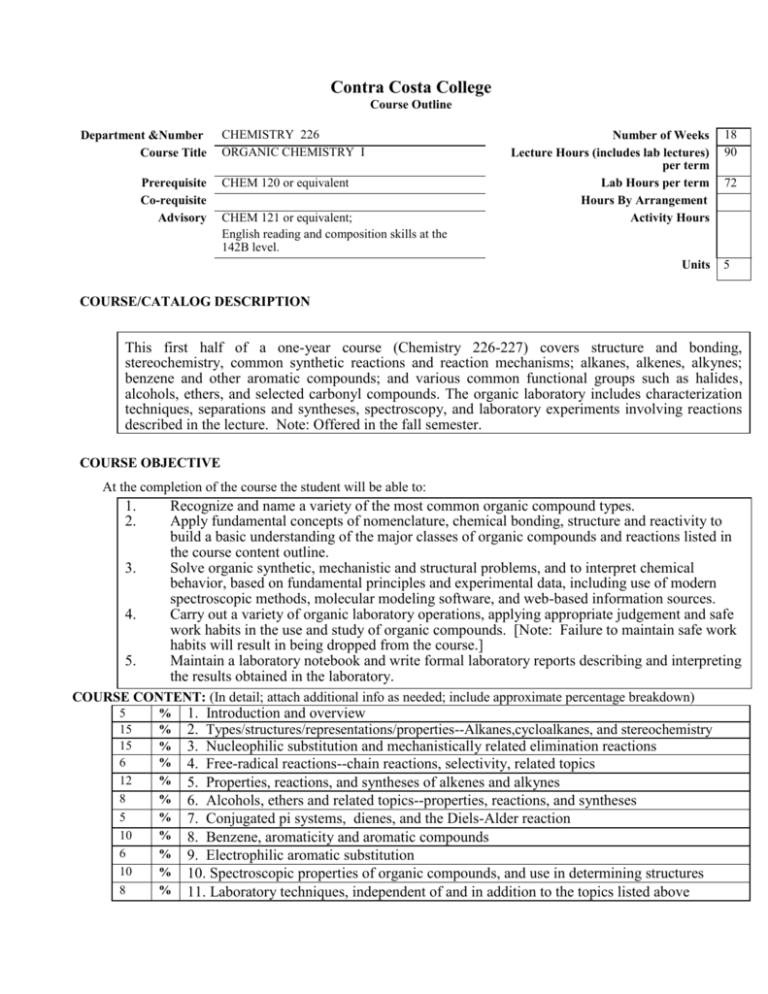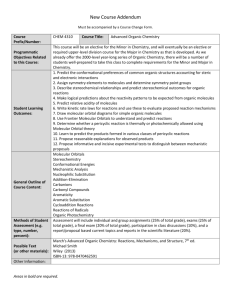
Contra Costa College
Course Outline
Department &Number
Course Title
Prerequisite
Co-requisite
Advisory
CHEMISTRY 226
ORGANIC CHEMISTRY I
CHEM 120 or equivalent
CHEM 121 or equivalent;
English reading and composition skills at the
142B level.
Number of Weeks
Lecture Hours (includes lab lectures)
per term
Lab Hours per term
Hours By Arrangement
Activity Hours
Units
18
90
72
5
COURSE/CATALOG DESCRIPTION
This first half of a one-year course (Chemistry 226-227) covers structure and bonding,
stereochemistry, common synthetic reactions and reaction mechanisms; alkanes, alkenes, alkynes;
benzene and other aromatic compounds; and various common functional groups such as halides,
alcohols, ethers, and selected carbonyl compounds. The organic laboratory includes characterization
techniques, separations and syntheses, spectroscopy, and laboratory experiments involving reactions
described in the lecture. Note: Offered in the fall semester.
COURSE OBJECTIVE
At the completion of the course the student will be able to:
1.
2.
3.
4.
5.
Recognize and name a variety of the most common organic compound types.
Apply fundamental concepts of nomenclature, chemical bonding, structure and reactivity to
build a basic understanding of the major classes of organic compounds and reactions listed in
the course content outline.
Solve organic synthetic, mechanistic and structural problems, and to interpret chemical
behavior, based on fundamental principles and experimental data, including use of modern
spectroscopic methods, molecular modeling software, and web-based information sources.
Carry out a variety of organic laboratory operations, applying appropriate judgement and safe
work habits in the use and study of organic compounds. [Note: Failure to maintain safe work
habits will result in being dropped from the course.]
Maintain a laboratory notebook and write formal laboratory reports describing and interpreting
the results obtained in the laboratory.
COURSE CONTENT: (In detail; attach additional info as needed; include approximate percentage breakdown)
5
15
15
6
12
8
5
10
6
10
8
%
%
%
%
%
%
%
%
%
%
%
1. Introduction and overview
2. Types/structures/representations/properties--Alkanes,cycloalkanes, and stereochemistry
3. Nucleophilic substitution and mechanistically related elimination reactions
4. Free-radical reactions--chain reactions, selectivity, related topics
5. Properties, reactions, and syntheses of alkenes and alkynes
6. Alcohols, ethers and related topics--properties, reactions, and syntheses
7. Conjugated pi systems, dienes, and the Diels-Alder reaction
8. Benzene, aromaticity and aromatic compounds
9. Electrophilic aromatic substitution
10. Spectroscopic properties of organic compounds, and use in determining structures
11. Laboratory techniques, independent of and in addition to the topics listed above
COURSE CONTENT: Laboratory Experiment Details
1.
2.
3.
4.
5.
6.
7.
8.
9.
10.
Laboratory Safety and Equipment
Solubility Principles and Practice
Crystallization Techniques
Analgesics Characterization
Thin Layer Chromatography
Simple and Fractional Distillation
Isolation of Clove Oil and Characterization using Infrared Spectroscopy
Extraction of Caffeine from Tea
Molecular Modeling using computer and manipulatives
Carvones
11.
12.
13.
14.
15.
16.
17.
Reactivities of Alkyl Halides
Synthesis and characterization of 4-methylcyclohexene
Piperidine Isolation and Characterization
Menthol from Menthone
Synthesis and characterization of t-pentyl chloride
Nuclear Magnetic Resonance principles and exercises
NMR practice
METHODS OF INSTRUCTION
1. Lectures, including lecture demonstrations.
2. Classroom discussions and problem-solving.
3. Laboratory exercises, including traditional "wet labs", instrumental techniques, and computer and webbased applications.
Other comments: Students are encouraged to work on their own and in study groups to solve exercises from
the text. To aid in preparation for exams and quizzes, selected examples from previous years are made
available. Answer keys are posted and/or made available on the web after exams and quizzes. Students are
encouraged to keep track of problems that give particular difficulty, and to bring their questions up in class or
in office hours. Several of the lab exercises have been locally developed.
INSTRUCTIONAL MATERIALS
LectureText Title:
Organic Chemistry
Author:
T. W. G. Solomons and C. B. Fryhle
Publisher:
Edition/Date:
Wiley
Tenth Edition, 2011
Note: There are numerous other, equivalent organic chemistry textbooks which could be used
for Chemistry 226. A partial list of choices would include:
J. McMurry, Organic Chemistry, Brooks/Cole 2007.
J. Smith, Organic Chemistry, McGraw Hill, 2008.
W. Brown, C. Foote, B. Iverson, E. Anslyn, Organic Chemistry, Brooks/Cole, 2009.
M. Jones, Jr., Organic Chemistry, Norton 2009.
F. A. Carey, Organic Chemistry, McGraw Hill 2010.
L. G. Wade, Organic Chemistry, Pearson/Prentice Hall, 2010.
Lab Text Title:
Introduction to Organic Lab Techniques: A Microscale Approach
Author:
D. L. Pavia, G. M. Lampman, G. S. Kriz and R. G. Engel
Publisher:
Edition/Date:
Brooks/Cole
Fourth edition, 2006.
Note: There are numerous other, equivalent organic chemistry laboratory texts which could be
used for Chemistry 226. A partial list of choices would include:
A. Ault, Techniques and Experiments for Organic Chemistry, University Science
Books 1998.
D. W. Mayo, R. M. Pike, D. C. Forbes, Microscale Organic Laboratory: with Multistep
and Multiscale Syntheses, 5th Edition, Wiley, 2011
J. R. Mohrig, C. N. Hammond, P. F. Schatz, and T. C. Morrill, Modern Projects
and Experiments in Organic Chemistry, Freeman 2003.
J.C. Gilbert and S. F. Martin, Experimental Organic Chemistry—A Miniscale and
Microscale Approach, 5th Edition, Brooks/Cole 2011.
Other Materials:
Molecular Model Kit (Various types are available.).
Laboratory notebook
Calculator
Safety goggles
COURSE EXPECTATIONS
Outside of Class Weekly Assignments
Weekly Reading Assignments
Weekly Writing Assignments
Weekly Problems
Lab or Software Application Assignments
Other Performance Assignments
Hours per week
3
2
6
1
STUDENT EVALUATION: (Show approximate percentage breakdown for evaluation instruments)
11
44
23
22
%
%
%
%
Quizzes
Midterm exams
Laboratory work, via notebook and reports
Final exam
GRADING POLICY (Choose LG, CR/NC, or SC)
Letter Grade
90% - 100% = A
80% - 89% = B
65% - 79% = C
50% - 64% = D
Below 50% = F
Credit / No Credit
65% and above = Credit
Below 65% = No Credit
X
Student Choice
90% - 100% = A
80% -90% = B
65% -79% = C
50% 64% = D
65% and above = Credit
Below 65% = No Credit
Note: The course is not graded on the “curve”, so the final grade breakdown can vary considerably
from year to year. Typical grade breakdown would be: A=20-30%, B=40-50%, C=30-40%, D/F=010%.
Prepared by: Leslie Alexander, Ph.D.
Date: October, 2013




